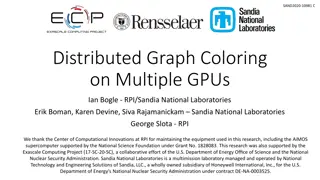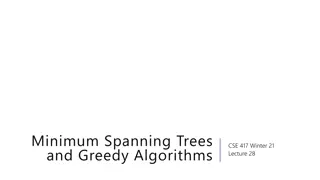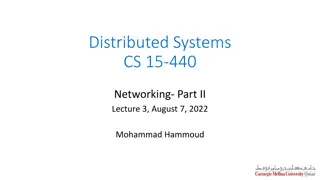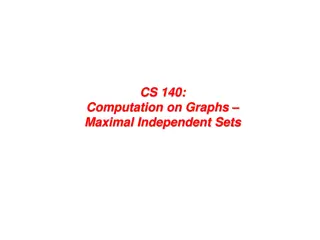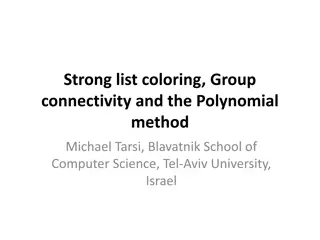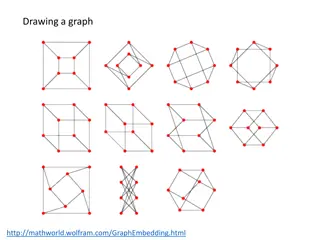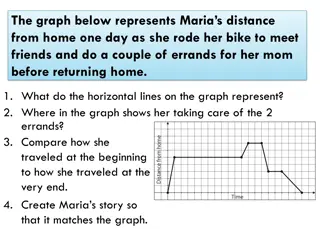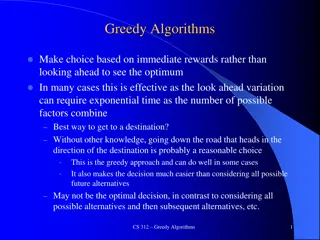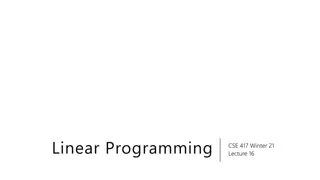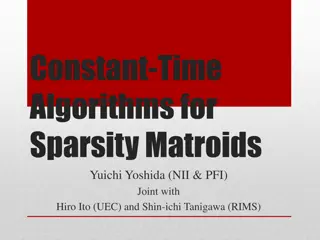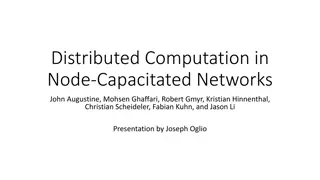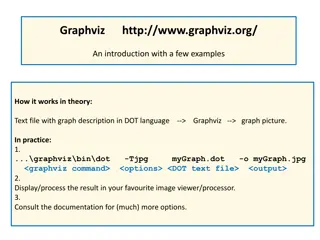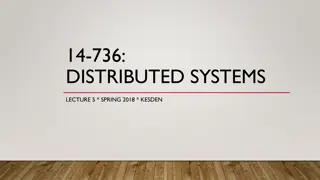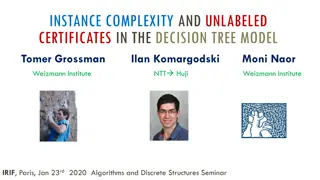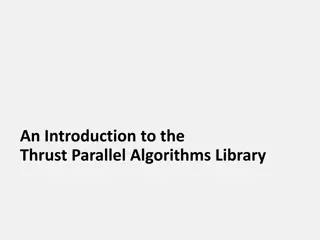Distributed Graph Algorithms: Introduction and Tree Coloring
This class introduces the fundamentals of distributed graph algorithms focusing on network modeling, complexity measures, solving graph problems, and comparing distributed vs. centralized algorithms. It covers topics such as the LOCAL model, synchronous rounds, communication rounds, computation time, and hybrid teaching methods. Key concepts include node identifiers, neighbor interactions, and time complexity analysis.
Uploaded on Sep 11, 2024 | 0 Views
Download Presentation

Please find below an Image/Link to download the presentation.
The content on the website is provided AS IS for your information and personal use only. It may not be sold, licensed, or shared on other websites without obtaining consent from the author. Download presentation by click this link. If you encounter any issues during the download, it is possible that the publisher has removed the file from their server.
E N D
Presentation Transcript
Distributed Graph Algorithms Spring 2021 Class 1: Introduction + Tree Coloring
Administrative details Hybrid teaching (after Passover) ~ 4-5 exercises Home exam \ final assignment TA: Avi Cohen (avi.cohen@Weizmann.ac.il) Course webpage: https://www.weizmann.ac.il/math/parter/courses/distributed-graph- algorithms-s2021
Distributed Graph Algorithms Network is modeled as a graph ? nodes with unique identifiers Initially each node knows: Its ID and IDs of its neighbors 8 5 7 3 Synchronous rounds: 1. Each node/computer does some internal computation 2. Send a message to each neighbor 3. Receive message from each neighbor 2
Distributed Graph Algorithms Network is modeled as a graph ? nodes with unique identifiers 8 5 7 Complexity measures: Number of rounds Number of messages \ bits 3 2 time complexity = number of rounds
Slide by Fabian Kuhn Objective: solve some graph problem on the network graph 12 15 9 20 21 1 8 4 11 3 16 2 17 5 At the start: Each node knows its own ID+ neighbors IDs, and nothing else about the topology At the end: Each node knows its part of the output (e.g., its color) time complexity = number of rounds
Distributed vs. Centralized Algorithms Distributed Setting Distributed Setting Centralized Setting Centralized Setting Shortest path ? Min. cut Computation time Computation time Communication rounds Communication rounds
Distributed vs. Centralized Algorithms Distributed Setting Distributed Setting Centralized Setting Centralized Setting Shortest path ? Min. cut ? ? Computation time Computation time Communication rounds Communication rounds
The LOCAL Model (Linial, FOCS 87) ? nodes with unique identifiers 8 5 Initially each node knows: Its ID and IDs of its neighbors Estimate on global parameters: E.g., number of nodes, max-degree, etc. 7 3 2 Synchronous rounds: 1. Each node/computer does some internal computation 2. Send a message to each neighbor (possibly unbounded) 3. Receive message from each neighbor Unbounded internal computation & message size
Slide by Fabian Kuhn The LOCAL Model The LOCAL Model ? Trivial upper bound: ?(???? ? ) rounds ?-Round Algorithm: Each node computes its output as a function of the initial state of its ?-neighborhood 11
Slides by Fabian Kuhn Local Graph Algorithms Objective: solve some graph problem on the network graph 12 15 9 20 21 1 8 4 11 3 16 2 17 5 At the start: Each node knows its own ID and nothing else about the topology At the end: Each node knows its part of the output (e.g., its color) Local checkability We consider graph problems where the solution can be checked locally (e.g., ?(1)-radius ball) e.g., a node can locally check whether it has a different color than its neighbors [Naor,Stockmeyer; STOC 93], [Fraigniaud,Korman,Peleg; FOCS 11] 12
Slide by Fabian Kuhn LOCAL Problems (Examples) LOCAL Problems (Examples) ? + ? -Vertex Coloring Objective: properly color the nodes with + 1 colors : maximum degree + 1 colors: what a simple sequential greedy algorithm achieves 13
Slide by Fabian Kuhn LOCAL Problems (Examples) LOCAL Problems (Examples) Maximal Independent Set (MIS) Objective: compute a maximal independent set (MIS) Non-extendible set of pairwise non-adjacent nodes Trivial to compute sequentially 14
Slide by Fabian Kuhn LOCAL Problems (Examples) LOCAL Problems (Examples) Maximal Matching Objective: compute a maximal matching Non-extendible set of pairwise non-adjacent edges A maximal matching is an MIS of the line graph 15
Challenges in the LOCAL Model Slide by Fabian Kuhn Symmetry Breaking / Local Coordination ? ? Neighboring / nearby nodes need to output different values e.g., different colors, at most one can be in an MIS, etc. Nodes need to decide in parallel Key Challenge: locally coordinate among nearby nodes randomization naturally helps (e.g., choose color at random) 16
The CONGEST Model (Peleg 90) ? nodes with unique identifiers 8 5 Initially each node knows: Its ID and IDs of its neighbors Estimate on global parameters: E.g., number of nodes, max-degree, etc. 7 3 2 Synchronous rounds: 1. Each node/computer does some internal computation 2. Send a message to each neighbor 3. Receive message from each neighbor ?(log ?) bits Unbounded internal computation & message size ?(log ?)
Distributed Graph Problems CONGEST Model LOCAL Model 2 2. Global Problems . Global Problems 1 1. Local Problems . Local Problems Minimum Spanning Tree Shortest Path Minimum Cut Maximum Flow Vertex Coloring Maximal Independent Set Maximal Matching Ruling Sets
Next: Coloring Trees with Next: Coloring Trees with 3 3 Colors! Colors!




